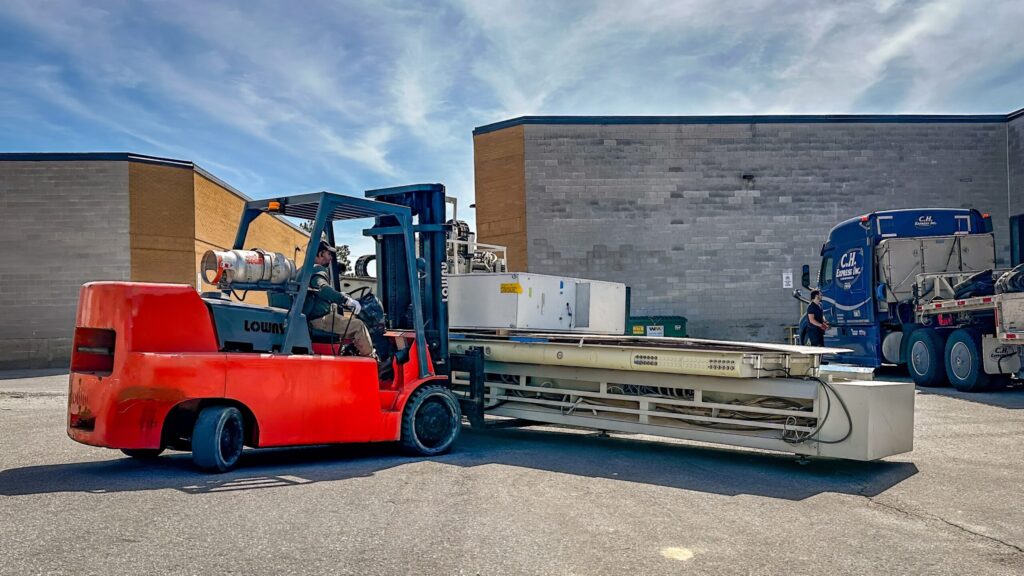Moving a factory in Canada is not a very simple process. The process involves a need to meet legal requirements, schedule management, interact with other key teams in the project, and overall planning. Undoubtedly, the transportation of big, delicate, and quite often invaluable pieces of manufacturing equipment is one of the most difficult tasks during an industrial relocation. If you’re planning a relocation, understanding the logistics of machinery moving is critical to your success.
In this comprehensive guide, we’ll explore everything you need to know about working with machinery movers, the essentials of moving heavy machinery, and how to plan a seamless relocation for your facility anywhere in Canada.
Why Factory Relocation Demands a Specialized Approach
The points above differentiate factory relocation from the typical moving of an office or retail store. Industrial situations encompass numerous types of machines, permanent fixtures, and proprietary or permanently wired equipment, much of which may need to be dismantled, disassembled, and transported in a particular manner.
This is especially the case in situations where one is engaged in the process of moving from one location to the other. That’s why working with experienced professionals in machinery moving is crucial. From cranes and rigging to hydraulic jacks and flatbed transport, skilled machinery movers understand how to handle heavy-duty equipment with the care and precision it demands.
Step 1: Assess Your Equipment and Site Logistics
The first thing that needs to be done is to survey the site before a single bolt is installed. Using a spreadsheet or several field forms, count every piece of equipment and assess the following characteristics: dimensions, weight, age, and whether it was necessary to disassemble it partially. You will also need to evaluate the current and future layout of sites that have machines to establish whether the machinery requires alteration or not.
During this phase, a project manager—either in-house or provided by your chosen machinery movers—will evaluate access points, floor load capacities, and potential obstructions like overhead piping or limited entryways.
Key considerations during assessment:
- Total weight and size of each machine
- Disconnection and reinstallation requirements
- Structural support at the new site
- Safety and compliance regulations
- Necessary permits for transportation (especially for oversized loads)
Step 2: Choose the Right Machinery Movers
A person needs to understand that not all moving companies are capable of handling industrial moving. When it comes to moving heavy machinery, you need a team with the right certifications, safety training, equipment, and experience. Seek to identify industries with companies that have previous experience in factory relocations, especially in the specific industries you operate in.
What to look for in machinery movers:
- Heavy-duty transportation capabilities
- Trained rigging and hoisting specialists
- Knowledge of Canadian transportation laws
- Insurance coverage specific to high-value machinery
- Documents and materials as support for the project planning and risk management stage
Tip: Always request references from other moving projects, and it is also wise to show the movers around your house so that they have a clue of what the move requires before giving their quotation.
Step 3: Secure Permits and Plan for Transportation
The transportation of all oversized or overweight equipment has certain guidelines set that has to be followed in Canada. Besides that, you may require special permits, escorts, and an exact routing and navigation plan that can vary depending on the province. These are laid down measures to meet infrastructural and road security standards.
Experienced machinery movers will typically handle this part of the process for you. They will then negotiate for the permits with the respective local authorities and also organize when it would be most convenient to transport the trees; this is especially critical where there is traffic congestion or terrain of compound contours for the tree species concerned.
For instance, transporting a huge CNC machine from one state in Ontario to another or from one state in British Columbia may involve:
- Oversize load permits
- Nighttime or off-peak scheduling
- Police escorts or pilot vehicles
- Bridge or infrastructure assessments
Step 4: Coordinate Utilities and Shut-Down Procedures
Any of the equipment must first be shut down and disconnected to avoid unplanned movement. They are involved with freelance electricians, gas, and water services, and in-house safety officers. Should the shutdown method be improper, it may cause a lot of equipment deterioration or an increased tendency of workplace accidents.
Ensure that each disconnection is documented properly so that if the needed connection is to be restored at the new site, it will be easy to do so. Identify cables, wiring, as well as hydraulic lines, and produce assembly instructions for every machine. You’ll thank yourself later.
Also, it is recommended that all of the members of the particular sector be informed when there will be a shutdown so that they do not feel like the change is affecting their process.
Step 5: Execute the Move with Safety and Precision
Once everything is ready, your machinery movers will begin the actual relocation. This stage encompasses placing wires, hoisting, moving, and offloading of every piece of equipment that will be used in the construction of the dam. With moving heavy machinery, safety is always the top priority.
Properly trained crews will use tools like:
- Gantry cranes
- Forklifts
- Skates and dollies
- Hydraulic jacks
- Heavy-duty trailers
This stage may take between 1 day and several weeks if one is working with appropriate equipment and is located in the right location. This is the most critical time when communication has to be effective to ensure an understanding of the moving plan among transport drivers, on-site engineers, and other stakeholders.
Step 6: Reinstallation and Calibration
This is the next step that is followed once your machinery gets to the new facility, where it will be functioning. This entails refitting bolts in the machines, reconnecting utilities, and checking the machines as well as the equipment to make sure they are in order.
It is also advisable to take stock of whether the home needs improvements or repairs in terms of lighting. At times, shifts can be the best chance to update your plan or organize the production areas for optimality.
A reliable team should conduct efficiency tests for each machine and help your team restore the operations as soon as possible.
Step 7: Final Checks and Post-Move Optimization
After everything is reassembled and operational, conduct a final walkthrough. Double-check for:
- Correct machine positioning
- Stable power, water, and air supply
- Calibration accuracy
- Compliance with industry regulations
- Clean and safe workspaces
It is also crucial to assess the leftovers after the move. Are your processes more efficient? Is your equipment performing optimally after the move? Information from the staff and department heads could also be useful in improving the new layout or correcting any other areas that may not be satisfactory.
Conclusion: Successful Factory Relocation Starts with the Right Team
Moving a factory to a new location may sound very challenging, if not impossible, especially in Canada, but this is not the truth at all because, with strategy and professionalism, this can be very easy. Choosing the right machinery movers is arguably the most critical step—these specialists bring the tools, knowledge, and safety protocols needed for handling large-scale equipment moves.
From site assessments to moving heavy machinery across provinces, every phase of your relocation should be handled with precision. And if you get it well supported, you are free from facing such costs for a long tim,e hence protecting your assets and also guaranteeing you a quick one for effective functionality.
Therefore, when planning for a factory move, there are no areas you can afford to take a chance with. Partner with a trusted expert in machinery moving and make your relocation a success from start to finish.






